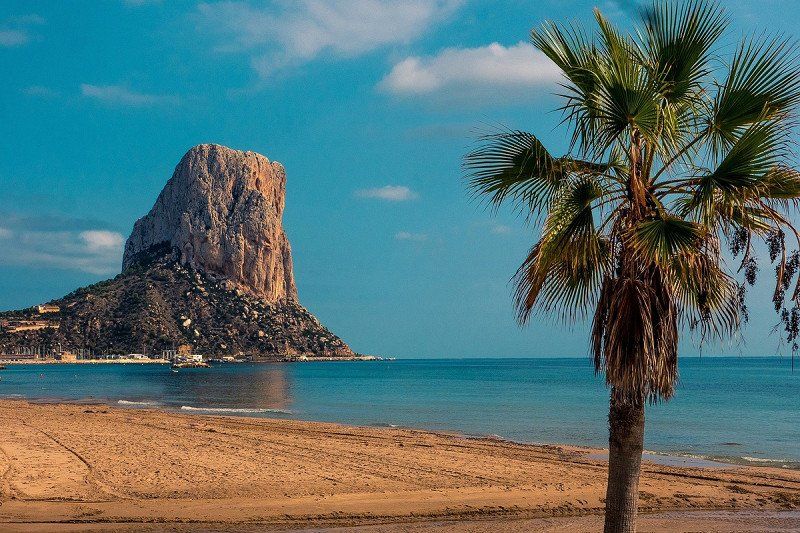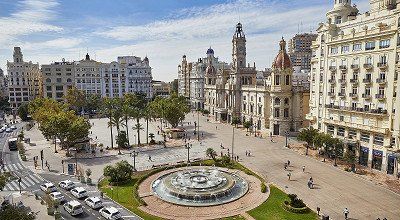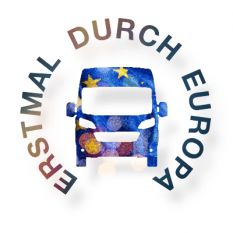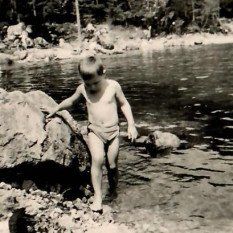Who hasn't heard of Barcelona, or maybe even Valencia, on Spain's east coast? But what about the picturesque nature parks, whitewashed fishing villages, quaint mountain villages and surreal volcanic landscapes on Spain's Mediterranean coast? Many gems are hidden between the Costa Brava and the Costa Cálida, waiting for you to discover them. Freeontour has put together a few highlights for your next road trip along the Spanish Mediterranean coast.
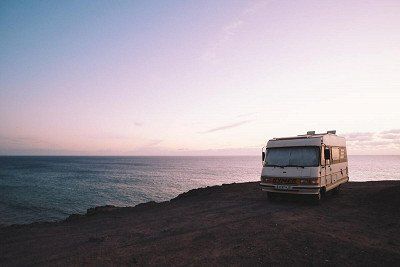
Spain's Mediterranean coast in the low season – an ideal destination for campers
Stretching almost 800 kilometres, the route has plenty in store for caravan and motorhome owners, including spectacular views of the sea and numerous exciting places. But most importantly of all, caravanners can simply take it easy. Although there are many tourists in and around the coastal towns in summer, the low season shows its more natural, lonely side. The climate on the Spanish Mediterranean coast is delightfully mild and full of sunshine in spring and autumn, yet not too hot, therefore ideal for exploring the area and visiting (cultural) sights and attractions. Heated up during the summer months, the Mediterranean Sea remains nice and warm for swimming well into autumn while the cooler nights allow for a pleasant sleep. Moreover, not only are the campsite prices cheaper before and after the summer rush, but there is also less traffic and congestion on the roads, no long queues in front of popular destinations and more parking spaces available.
Campers can also look forward to a good infrastructure on the Spanish east coast. Most campsites are only open until mid-October, but you will still find a wealth of places that welcome guests all year round, making them perfect for winter getaways. Many campsites and RV sites are located in beautiful settings where campers can make the most of the beautiful views of the green hinterland or sea.

Road trip stage #1: Girona and the Costa Brava
The Freeontour road trip starts in the photogenic city of Girona – a treasure of medieval architecture exuding the charm of a bygone era thanks to its proud castle and picturesque cathedrals. This enchantment hasn't gone unnoticed by the film industry, such as when the city served as one of the sets for the fantasy saga Game of Thrones. The oldest parts of Girona's city walls were built by the Romans in the 1st century BC.
Must-see highlights & sights in Girona:
- Fall in love with the Old Town and sea viewwhile walking the castle wall
- Admire the colourful houses on the Onyar river from one of the bridges
- Visit the Cathedral of Saint Mary, which towers over the Old Town as a landmark, and take in the beauty of the city from up here
- Look around the Arabian thermal baths and feast your eyes on the architectural mixture of Roman columns and oriental flair
The area around Girona is just as picturesque. Away from the beaten track and tourist strongholds such as Lloret de Mar, the Costa Brava, i.e. Wild Coast, is abundant in natural bays and cultural surprises.

Sights & tips for the Costa Brava:
- Coastal walk between rugged bays and dazzling whitewashed fishing villagesA hiking trail boasting great views connects three romantic coastal towns blessed with fine sandy beaches: starting from the small town of Tamariu past Sant Sebastià (Spain’s most powerful lighthouse) to the hamlet of Llafranc and then on to the whitewashed village of Calella de Palafrugell. The hike takes about 2.5 hours. After stopping over in Calella, you can either hike back to the starting point through the hinterland, which will take a good hour, or take a taxi.
- Inspiring ideas for secluded natural bays
The Costa Brava has many hidden unspoilt beaches and bays, such as the rugged Platja d'Aigua Xelida with its rock cave surrounded by pine trees and the long Platja de Castell framed by pine groves.
- Culture in Girona's hinterland
The artist Dalí left his mark in the romantic medieval towns of Figueres (Dalí's birthplace) and Púbol, e.g. in the Dalí Theatre and Museum in Figueres and the Gala Dalí Castle House-Museum in Púbol.
- Breathtaking panoramic road with sea views
The GI-682 between Tossa de Mar and Sant Feliu de Guíxols.

Road trip stage #2: Barcelona and the Costa Dorada
We now head to Barcelona, Gaudí's artistic playground and one of the most exciting and popular cities in Spain. From romantic alleys to surreal buildings (thanks to Gaudí), tapas temples, cable cars, panoramic views and more, there's so much to experience here – Freeontour has put together a small selection below, which is presented in more detail in a separate article about Barcelona.
Must-see highlights & sights in Barcelona:
- Eat tapas! A short excursion into the Catalan tapas world: our recommendations include patatas bravas (crispy potatoes with two different dips: spicy and garlic), pimientos de padrón (fried small green peppers), Camembert (fried crispy with a sweet cranberry sauce), rabo de toro (oxtail stew), jamón Ibérico (very fine ham from black pigs that eat acorns and herbs) and tarta de queso (the Catalan answer to cheesecake)
- Visit La Sagrada Familia (warning: long waiting times; it's best to book online beforehand), the unfinished church designed by Gaudí, which looks like something out of a sci-fi film
- Enjoy colourful art and views over the city in Gaudí's Park Güell
- Take a ride in Barcelona's cable cars and savour the panoramic views

Sights & tips for the Costa Dorada:
- Discover natural baysTranslated as the Golden Coast, the Costa Dorada owes its glamorous name to the golden sand that adorns many of its bays. Although large parts of the coast are built up with hotels, you'll still be able to find natural bays, such as Cala Jovera in Tamarit with its castle from the 12th century, the beautifully unspoilt Cala de I'Illot and the wild Cala Fonda, often referred to as Waikiki due to its similarity to the Hawaiian beach.
- Active nature experiences in the Ebro Delta
The Ebro Delta is a wetland with a wide variety of plants and wildlife and includes a large natural park. Wide rice fields for the typical Catalan rice and flat, water-rich landscapes inhabited by flamingos and other bird species stretch as far as the eye can see. A bike tour or hike is an excellent way to experience the nature here.
- Day trip to Tarragona
Bloody gladiator fights once took place in the well-preserved Roman amphitheatre, which is a UNESCO Heritage Site today. The Roman aqueduct in the north of the city, 217 metres long and 27 metres high – also known as Devil's Bridge – takes visitors back in time to the region's rich past.
- Cultural excursion inland
On to Reus, the birthplace of Gaudí, where you can visit the Gaudí Centre. If you prefer something more lively, you can visit the seaside town of Sitges, known for its fiestas and carnival in late February.
- Stunning panoramic serpentine road with a view of the rocky coastal landscape
The C-31 Castelldefels and Sitges.

Road trip stage #3: In and around Valencia
The origin of paella seems to be a point of contention in Spain. However, it has been historically proven that the actual birthplace of this popular Spanish dish was Valencia, a town located between the Costa del Azahar and the Costa Blanca. So it's not surprising that dozens of restaurants here offer paella, often still in its original form: traditional Paella Valenciana is made with rabbit, chicken, snails and vegetables. But different takes on this dish have also been around for a while, such as the seafood and fish version that is popular with holidaymakers as well as vegetarian ones.
Must-see highlights & sights in Valencia:
- Eat paella and go on a trip to the nearby La Albufera Natural Park, where you can take boat tours to explore the marshland where paella originated: with simple rice farmers who made their livelihood from what nature provided them. There are floating rice paddies in La Albufera to this day
- Beach tip: the Playa El Saler beach in La Albufera Natural Park is a large natural beach with many dunes and perfect for long walks on the beach
- Visit the City of Arts and Sciences (La Ciudad de las Artes y las Ciencias) – a modern architectural marvel made up of museums, providing a futuristic contrast to the medieval old town
- Go for a run in the Parque del Rio Turia city park or work out on the many fitness trails, just like the locals do. The Turia river once flowed here, but it was diverted in the 1950s due to a violent flood. Since then, the empty riverbed has become a huge urban space for leisure and physical activities
- Eat tapas at the quaint and hidden La Bodeguilla del Gato bar, which translates as "The Cat's Wine Cellar". The oxtail here is also superb

Sights & tips for the Valencian region:
- The Templar Castle in the coastal town of PeñíscolaIt's definitely worth climbing the legendary, fairytale-like Templar Castle in the coastal town of Peñíscola, which served as a backdrop for the Game of Thrones series – and is rightly a popular postcard motif.
- Hiking in the Sierra Calderona Natural Park
If you want to go higher, hike through the Sierra Calderona Natural Park and climb the Gorgo – at 907 metres, it's the highest peak in the Natural Park. The journey there alone is worth the trip thanks to the scenic winding country roads. Stop over at any of the charming little mountain villages on the way, such as Rubielos de Mora, Segorbe or Montanejos, which is a well-known hiking area and famous for its natural hot springs. But be careful: large motorhomes will at times find the route quite narrow and difficult to manoeuvre.
You'll find even more detailed information about sights and camping in Valencia in this separate article:

Road trip stage #4: Alicante and the Costa Blanca
Built by the Moors, the town of Alicante on the Costa Blanca is where the mountains meet the sea. The mountain range, affectionately known as the Sierra Grossa ("Fat Mountains"), stretches along the coast; and even the silhouette of Alicante is shaped by Mount Benacantil, overlooking the sea with its majestic castle. The side of the mountain resembles a face, therefore bears the nickname Cara del Moro, "The Moor's Face". You'll also find huge stones scattered around the province of Alicante waiting to be conquered or at least admired. The scenic CV-736 road to Alicante is an experience in itself.
Must-see highlights & sights in Alicante:
- Climb the 167-metre-high Mount Benacantil, visit the castle and admire Alicante from the top of its landmark
- Stroll through the Old Town and harbour and enjoy a few tapas along the way
- Take the tram for a scenic ride to the colourful little town of Villajoyosa. The line L1 starts from Mercat (market) in Alicante, travels leisurely along the coast in just under an hour and offers passengers breathtaking views during the journey to their destination – Villajoyosa, a colourful gem on the Spanish Mediterranean coast. Once there, you can sip a café con leche (milk coffee) and stroll past colourful little houses and shops selling handmade crafts – not a bad way to spend an afternoon, don't you think?

Sights & tips for the Alicante region and the Costa Blanca:
- Take a trip to the small, sleepy island of Tabarca from Alicante or the town of Santa Pola
Time has stood still here for centuries. You'll find some great natural beaches on this car-free islet, which is easy to explore on foot. The body of water around the island was declared Spain's first protected marine reserve in 1986.
- Hike to the Peñón d'Ifach
If you feel liking climbing a sleeping giant, head to the impressive Rock of Ifach towering over the town of Calpe (see header image), which is also a symbol of the Costa Blanca.
- Nature tip for the hinterland
Go to Elche, a UNESCO World Heritage Site, where you can see the largest palm grove in Europe.
- Explore pink saltwater lakes
Visitors to Las Lagunas de la Mata y Torrevieja Natural Park could be forgiven for thinking they're wearing rose-coloured glasses – pink-coloured microorganisms, which also influence the colour of the plumage of the flamingos wading here, have turned two saltwater lakes pink. The many hiking and biking trails make it easy to explore the park on foot or by bike.

Road trip stage #5: Natural gems on the Costa Cálida
We continue onwards to the Costa Cálida ("The Warm Coast"), which is relatively far south on the Iberian peninsula. There are more oriental influences the further south you venture as the Moors once reigned here, and in fact their conquest of Spain began on this coast. Roughly an hour's drive from the sea, the city of Murcia is not necessarily one of the country's tourist hotspots, which has helped it keep its authentic charm, but there is not much to see or do here. However, near Murcia and in its hinterland you'll be able to experience Mother Nature at her best. For this reason, we won't dwell on the actual town any longer, and instead will focus on the natural sights.

Sights & highlights on the Costa Cálida:
- Mazarrón, a surreal lost place
Visiting the ruins of the abandoned city of Mazarrón is tantamount to a mission to Mars. The former ore mine slumbers in the desert-like landscape, coloured red by iron. The Romans were the ones to discover the mineral resources and the mine was in operation for centuries until 1969. The ruins are open to the public, but you will still need to be careful while exploring the area due to the open mineshafts. You can park on the outskirts of Mazarrón on the RM-607.
- Hiking in and around San Pedro del Pinatar
Explore the quiet fishing village of San Pedro del Pinatar and hike through its beautiful surroundings from one romantic windmill and salt lake to another.
- Visit the Mar Menor saltwater lagoon
Pristine dune beaches and a calm sea await you in the bay of the Mar Menor saltwater lagoon, its name meaning "Smaller Sea". Due to climate change and pollution from businesses and mining operations, Spain's senate very recently granted it legal status as a person to protect it, making it the very first ecosystem in Europe to be given the same legal rights as a person.
- Beach walks in the Cabo de Gata-Níjar Natural Park
The Cabo de Gata-Níjar Natural Park in the province of Almería is volcanic and looks like a desert. It boasts beautiful beaches with partly dark sand and basalt columns. Small, charming coves such as Calas del Barronal are perfect for taking long walks on the beach where you will be amazed by the black volcanic surroundings.


